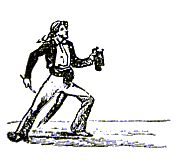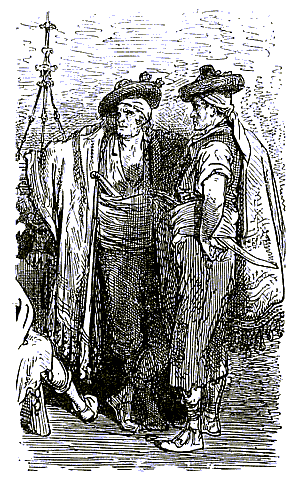
LESSON EIGHT
CAMBIOS

Of the various ways there are of wielding the navaja, the best and most secure is he who is acomplished with both hands, that is to say, can use either one for wielding the navaja, although some place on one of the arms a cape, mantle or jacket, or better still the hat in the hand. Yet despite this manner of wielding the navaja having a few advantages, it brings with it many disadvantages that should be taken into consideration. Actualy, if we pay attention only to the ease with we can obscure the vision of the opponenent with the hat in the hand, and to the obstacle which this presents, in the manner of a shield, to the golpes that come at the diestro, surely we should adopt this ancient custom; but if we stop to examin the many disadvantages of not being able to execute the cambios nor attack except from the side of the armed hand, and the exposure and risk that is inherent to the guardia which is required by this manner of fighting, as represented in this figure, we deduce without any doubt that the method most secure and with the most recourses is that using both hands for the fight, or that is one hand armed and the other unarmed and free, but in a disposition to be able to take the navaja from the other hand which is then left unarmed.
Such is the speed that is necessary for this way of fighting, which is called cambio, that when two tiradores are set in combat, the eyes of one can scarecly determine in which hand of the other the navaja may be found; and from here he does not risk to attack except with a greater agility, which in similar circumstances is needed for the other manner of tirar which has been refuted above.
Do not think that we disaprove on all occasions of the diestro occupying one hand with the hat; on the contrary it is acceptable in some cases, consider it as a specialized area of the art, an isolated school, nevertheless as worthy of being retained as any other.
When using this way of fighting during combat, we advise the diestro to not remove the hat from the head and to not let it fall to the ground in the various corridas and huidas that are made, with the object of seizing it on opportune occasions and placing it in the unarmed hand, or throwing it at the eyes of the enemy, or for feigning only, as will later be discussed. It is of great utility to the diestro to wear a sash around the waist, to cover a part of his abdomen and sides, so as to resist to some extent at least a few of the desjarretazos and viajes, also to execute various tretas with it, which will be explained in their respective place.

When the diestro is summoned or provoked to fight take care, if wearing a cape, to throw it in a spot where it cannot inconveniently entangle itself on your feet; there is no mode fighting with it placed upon the shoulders, because it impedes you very much in your movements, even if it is often good for helping to keep you from being wounded; be advised to always abandon the cape when fighting.
The cape can be removed with speed and in a manner that will not hinder the legs of the diestro. This way consists in making a small shrug of the shoulders, simultaneously giving a slight shake with the middle part of the arms; and the cape gently spreads out on the ground in the form of a half moon or fan. This method of removing the cape without risk of entrapping the feet of the diestro, has an object of not losing sight of the enemy, as would certainly happen if the head were turned away, as is done by those who would try to throw the cape from their terreno; in which case it is obvious they will be attacked before they can even blink; it should be cautioned that, unfortunately, not all of those who wield the navaja, have generosity and good intentions. We offer this warning because, as indicated in the prolog, it is not passion for the art of tirar a la navaja and a desire to spread its teaching, that moves us to write this Manual; it is only for those who are ignorant of its method of use, to inform them of its precepts for when they are attacked by those who abuse them, in the same manner that any other class of arm may be abused.
We want to dispel all worry, show that it is within the reach all people to understand the ways of the art, sometimes condemnable and of bad character, which the tiradores themselves use for fighting against those who do not even know how to take the navaja in their hand. With the reading of this Instruction and a little easily aquired practice, any almibarado señorito* can at least defend himself from the brusque attack of a baratero.
*almibarado señorito: "momma's boy"